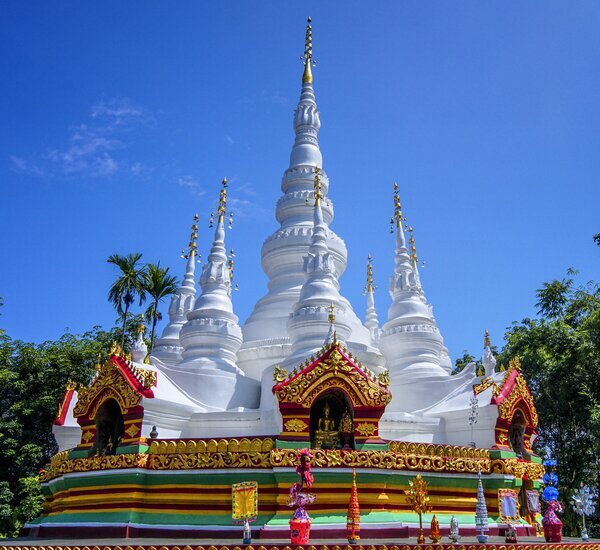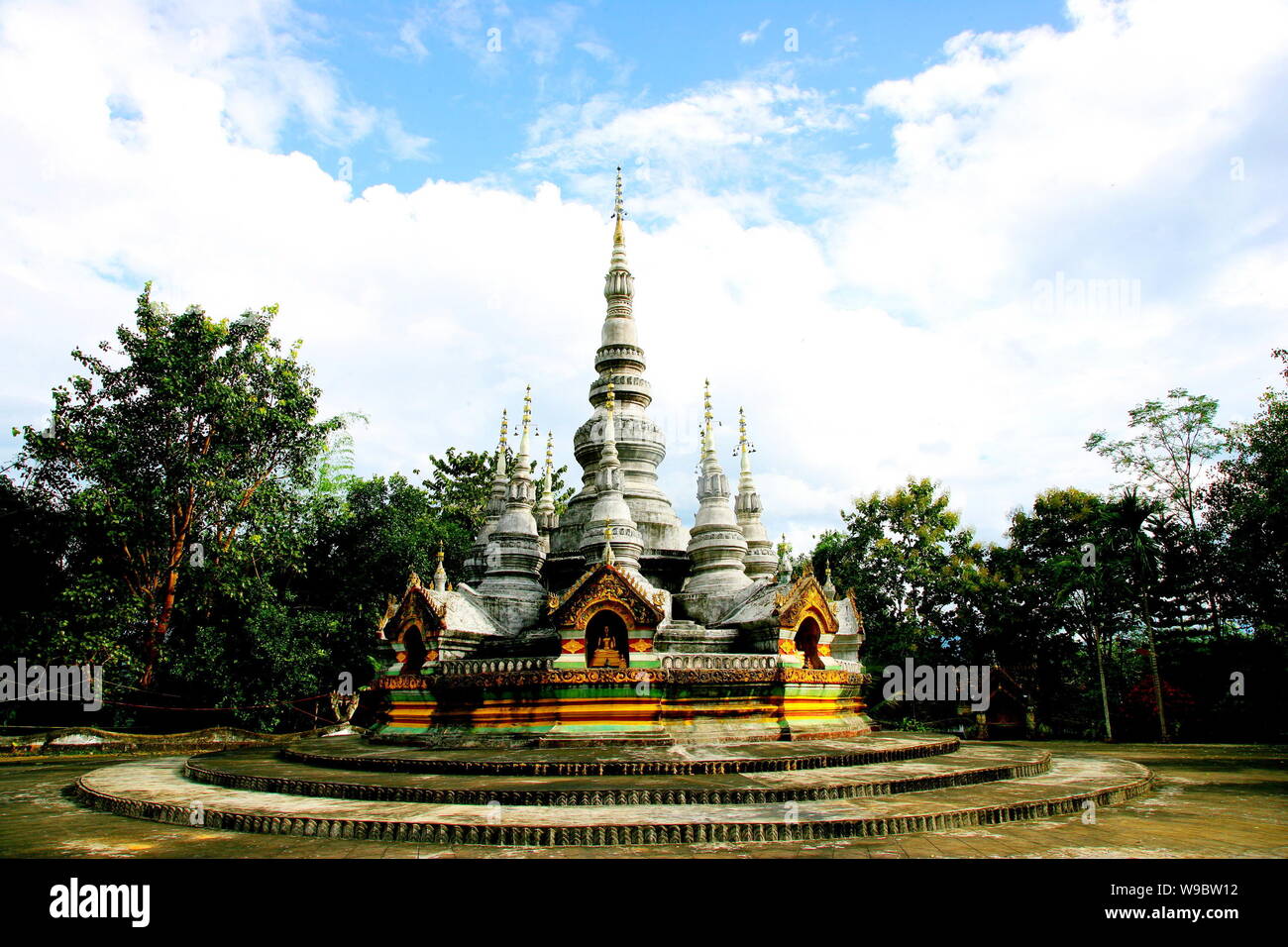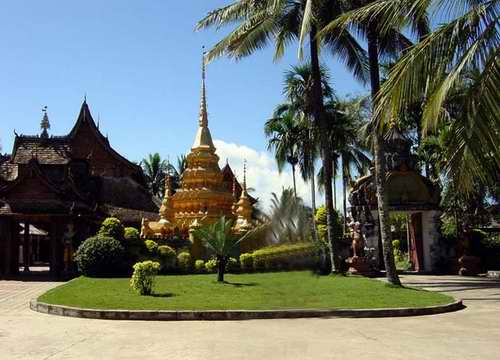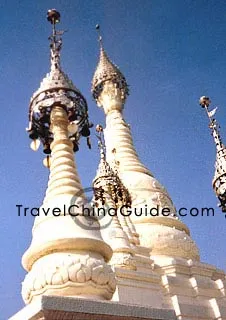Top 5 Reasons to Visit Manfeilong Pagoda in Xishuangbanna

An Essential Guide to Visiting Xishuangbanna Manfeilong Pagoda
Nestled in the lush, tropical landscape of Yunnan Province, Xishuangbanna’s Manfeilong Pagoda stands as a testament to the region’s rich Buddhist heritage and stunning architectural artistry. Often referred to as the “Bamboo Shoot Pagoda” due to its remarkable resemblance to young bamboo sprouting from the earth, this unique cluster of stupas is a sight to behold. With its central stupa soaring 16.3 meters high, surrounded by eight graceful smaller pagodas, the ensemble captivates visitors with its striking white façade that gleams under the golden sun, creating a scene that is nothing short of magical.
Constructed in the 1200s, Manfeilong Pagoda represents a blend of cultural influences, drawing inspiration from the Theravada Buddhist traditions of nearby Southeast Asian countries. Pilgrims and tourists alike journey from across the globe to pay homage to the entombed bodhisattvas and to absorb the tranquil ambiance that envelops the site. Whether you are a devout Buddhist seeking solace or a curious traveler eager to explore the art and history of the area, Manfeilong Pagoda offers a profound experience steeped in spirituality and beauty.
As you prepare to embark on your journey to this enchanting locale, let this guide serve as your compass, leading you through the rich tapestry of history, stunning views, and cultural insights that await at the Manfeilong Pagoda. Discover the best times to visit, what to see, and how to immerse yourself in the vibrant local traditions that make this destination a must-visit on your adventure through China.
In This Guide
- An Essential Guide to Visiting Xishuangbanna Manfeilong Pagoda
- The Rich History and Legends of Xishuangbanna Manfeilong Pagoda
- Main Highlights: What You Absolutely Can’t Miss
- Planning Your Visit: A Practical Guide
- Tickets: Prices, Booking, and Tips
- How to Get There: A Complete Transportation Guide
- Local Cuisine and Accommodation Nearby
- Frequently Asked Questions
- Final Thoughts on Your Trip
The Rich History and Legends of Xishuangbanna Manfeilong Pagoda
Nestled in the lush hills of Xishuangbanna, the Manfeilong Pagoda stands as a testament to the rich cultural tapestry of the region. This striking group of stupas, often referred to as the “White Pagoda” or “Bamboo Shoot Pagoda,” dates back to the early 13th century, specifically around 1204 AD, when it was originally constructed by three Indian monks. Their vision was to create a spiritual sanctuary that would serve both as a place of worship and a symbol of the Theravada Buddhist architectural style that resonates throughout Southeast Asia.
The pagoda complex features a central stupa towering at 16.3 meters (53.4 feet), surrounded by eight smaller stupas, each standing at 9.1 meters (29.9 feet). The design of these stupas is reminiscent of bamboo shoots bursting forth from the earth, a nod to the local Dai culture that finds deep connections with nature. The white color of the stupas reflects the intense tropical sunlight, giving them an ethereal glow that can appear as pure as freshly fallen snow.
Historically, the Manfeilong Pagoda has served as a vital pilgrimage site for Buddhist devotees from across Southeast Asia, including Myanmar, Laos, and Thailand. Every year, countless believers journey from afar to pay homage to the entombed bodhisattvas, revered figures in Buddhism who embody wisdom and compassion. The pagoda’s spiritual significance is amplified during the Water Splashing Festival, held annually from April 13 to 15, when locals gather to celebrate and purify themselves in a joyous display of water and festivity.
The architectural features of the pagoda are equally captivating. Each stupa is adorned with intricate carvings and paintings depicting mythical creatures such as phoenixes and dragons, showcasing the artistic prowess of the artisans who crafted them. An octagonal base supports the central stupa, with niches that house exquisite Buddha statues, inviting visitors to pause and reflect on the teachings of Buddhism.
Visiting the Manfeilong Pagoda is not just an encounter with history; it is also an opportunity to immerse oneself in the vibrant culture of the Dai people. The surrounding area is rich with tropical flora, traditional Dai-style stilt houses, and the serene beauty of rubber plantations, offering a glimpse into the local way of life.
As you explore this historical gem, take a moment to appreciate the legends and stories that have woven themselves into the fabric of the Manfeilong Pagoda. Each stone and statue tells a tale of devotion, artistry, and the enduring spirit of a community that cherishes its heritage. Whether you are a history buff, a spiritual seeker, or simply someone with an eye for beauty, the Manfeilong Pagoda promises an unforgettable experience that resonates long after you leave its hallowed grounds.

Xishuangbanna Manfeilong Pagoda.
Main Highlights: What You Absolutely Can’t Miss
Discover the breathtaking beauty and cultural significance of the Manfeilong Pagoda, a must-visit destination in Xishuangbanna, Yunnan. Nestled on a hilltop just 70 kilometers south of Jinghong and close to the Burmese border, this iconic site is renowned for its striking architecture and rich Buddhist heritage.
Architectural Marvels
The Manfeilong Pagoda, often referred to as the White Pagoda, is a stunning cluster of stupas that embody the architectural style of Theravada Buddhism. The main stupa stands at an impressive 16.3 meters (53.4 feet) tall, surrounded by eight smaller stupas, each measuring 9.1 meters (29.9 feet). Together, they create a magnificent sight that resembles bamboo shoots sprouting from the earth, earning the pagoda the nickname Bamboo Shoot Pagoda.
The stupas are adorned with exquisite decorations, featuring intricate paintings and sculptures of mythical creatures like phoenixes and dragons, while Buddha statues grace the niches at the base of each stupa. Be sure to take your time exploring these artistic treasures and capturing their beauty through your camera lens, especially in the golden light of late afternoon or sunset.
Historical Significance
Believed to have been constructed in the early 1200s, the Manfeilong Pagoda holds deep historical and spiritual significance. Pilgrims and believers travel from far and wide to pay their respects to the entombed bodhisattvas, making it a profoundly sacred site. The pagoda’s historical roots and ongoing cultural practices provide insight into the rich tapestry of local beliefs and traditions.
Scenic Surroundings
The pagoda is set against a backdrop of lush tropical scenery, making the walk up Manfeilong Hill a delightful experience. As you ascend the 200 steps to the top, take in the stunning views of the surrounding jungle, traditional Dai-style stilt houses, and rubber plantations. This journey not only offers a chance to appreciate the natural beauty of Xishuangbanna but also to observe local life in the nearby villages.
Cultural Festivals
If your visit coincides with the Water Splashing Festival, celebrated annually from April 13 to 15, you’re in for a treat. This vibrant event attracts locals and tourists alike, offering a unique opportunity to engage with the local culture. Witness the joyous celebrations, where water is playfully splashed to symbolize good fortune and the washing away of the previous year’s misfortunes.
Practical Tips
- Best Time to Visit: The ideal time to explore the Manfeilong Pagoda is during the dry season from October to April, when the weather is pleasant and the surroundings are lush.
- Visiting Hours: The pagoda is open from 8:00 AM to 5:00 PM, so plan your visit accordingly to make the most of your time there.
- Duration: Allocate between 1 to 3 hours for your visit to fully appreciate the site and its surroundings.
Conclusion
The Manfeilong Pagoda is not just a site of architectural splendor but a vibrant cultural hub that reflects the spiritual essence of the region. Whether you’re a history enthusiast, a photography lover, or simply seeking a tranquil escape, this pagoda promises an unforgettable experience in the heart of Xishuangbanna. Don’t miss the chance to explore this captivating gem during your travels in Yunnan!

Xishuangbanna Manfeilong Pagoda.
Planning Your Visit: A Practical Guide
Visiting the Xishuangbanna Manfeilong Pagoda is a captivating experience that combines stunning architecture, rich culture, and beautiful natural landscapes. Here’s everything you need to know to make the most of your visit.
Getting There
The Manfeilong Pagoda is located approximately 70 kilometers south of Jinghong, the capital of Xishuangbanna. You can reach it by taxi or local bus, which makes for an interesting journey through the lush Yunnan countryside. If you prefer a more guided experience, consider joining a local tour that includes transportation.
When to Visit
The best time to visit the Manfeilong Pagoda is during the dry season, which runs from October to April. During these months, the weather is pleasant, making it ideal for exploration. Photographers should aim to visit in the afternoon or at sunset, as the golden light beautifully illuminates the white stupas, enhancing their stunning appearance.
Opening Hours
The pagoda is open to visitors from 8:00 AM to 5:00 PM. It’s advisable to arrive early to enjoy a peaceful atmosphere and avoid the crowds later in the day.
Recommended Duration
Plan to spend 1 to 3 hours at the pagoda. This allows ample time to explore the stupas, take photographs, and enjoy the surrounding tropical scenery. If you wish to hike up Manfeilong Hill for expansive views, adding an extra hour or two can be worthwhile.
What to See
The Manfeilong Pagoda consists of a central stupa surrounded by eight smaller ones, all designed in the traditional Theravada Buddhist style. The architecture is striking, with intricate decorations of phoenixes, dragons, and peacocks. In addition to admiring the pagodas, take a leisurely walk up the 200-step stairway to enjoy breathtaking views of the surrounding area, including local Dai-style stilt houses and rubber plantations.
Cultural Insights
The pagoda is not just a tourist attraction; it’s a significant religious site for Buddhists. Each stupa features niches that house Buddha statues, and you may witness local devotees offering prayers or incense. Engaging respectfully with the spiritual practices observed here can enrich your visit.
Nearby Attractions
After visiting the pagoda, consider exploring nearby sites such as:
– Olive Dam
– Wild Elephant Valley
– Dai Nationality Garden
These attractions offer a deeper insight into the unique culture and natural beauty of Xishuangbanna.
Tips for Travelers
- Dress Appropriately: As a religious site, modest clothing is recommended. Avoid shorts and sleeveless tops.
- Stay Hydrated: The tropical climate can be hot and humid, so carry water with you.
- Photography: While photography is encouraged, respect the local customs and ask for permission if photographing individuals.
Local Festivals
If your visit coincides with the Water Splashing Festival from April 13 to 15, don’t miss the opportunity to participate in this vibrant local celebration, which celebrates the Dai New Year with water games and cultural performances.
Guided Tours
For a more enriching experience, consider hiring a local guide. English is not commonly spoken in Xishuangbanna, and a knowledgeable guide can provide insights into the history, architecture, and significance of the pagoda, making your visit even more memorable.
Conclusion
The Manfeilong Pagoda is more than just an architectural marvel; it’s a gateway into the heart of Yunnan’s culture and spirituality. Whether you’re a photographer seeking the perfect shot, a traveler looking to explore new cultures, or a spiritual seeker wishing to connect with local traditions, a visit to this stunning site will surely be a highlight of your journey in Xishuangbanna.

Xishuangbanna Manfeilong Pagoda.
Tickets: Prices, Booking, and Tips
Visiting the Manfeilong Pagoda in Xishuangbanna is a remarkable experience, providing a glimpse into the rich history and culture of Theravada Buddhism. Here’s everything you need to know about tickets, prices, booking, and some handy tips to make the most of your visit.
Ticket Information
- Entrance Fee: The ticket price for visiting Manfeilong Pagoda is generally very affordable, typically around ¥20 (approximately $3 USD).
- Opening Hours: The pagoda is open daily from 8:00 AM to 5:00 PM. It’s best to arrive early to beat the crowds and enjoy the tranquility of the site.
Booking Tips
- Advance Booking: While tickets can usually be purchased on-site, if you’re visiting during peak tourist seasons or festivals (like the Water Splashing Festival from April 13 to 15), consider booking your tickets in advance to secure your spot.
- Guided Tours: If you’re keen on delving deeper into the cultural significance of the pagoda and its architecture, consider joining a guided tour. Many local tour operators offer packages that include transportation, a guide fluent in English, and additional insights into the surrounding areas.
Travel Tips
- Best Time to Visit: The ideal time to visit Manfeilong Pagoda is during the dry season, from October to April, when the weather is pleasant. For photographers, the late afternoon or sunset provides stunning lighting that beautifully illuminates the white stupas, creating a picturesque scene.
- Getting There: The pagoda is located about 70 kilometers south of Jinghong, making it accessible by taxi, private car, or organized tours from the city. The journey takes roughly 1.5 hours.
- What to Bring: Be sure to wear comfortable shoes suitable for walking, as there is a stairway with approximately 200 steps leading up to the pagoda. Don’t forget your camera to capture the beautiful architecture and surrounding tropical scenery!
Additional Experiences
While visiting the pagoda, take the time to explore Manfeilong village and enjoy local traditions. Engaging with villagers can provide a unique cultural experience, such as pottery making, which is a delightful activity for families.
With thoughtful planning and a spirit of adventure, your visit to the Manfeilong Pagoda promises to be a memorable highlight of your journey through Xishuangbanna!
How to Get There: A Complete Transportation Guide
Reaching the stunning Manfeilong Pagoda in Xishuangbanna, Yunnan, involves a combination of flights, ground transportation, and a bit of adventure. Here’s a comprehensive guide to ensure your journey is as smooth as possible.
Getting to Xishuangbanna
1. Fly into Jinghong Airport (JHG)
The closest airport to Manfeilong Pagoda is Xishuangbanna Gasa Airport (JHG), located about 70 kilometers north of the pagoda itself. Several airlines operate domestic flights to Jinghong from major Chinese cities such as Kunming, Chengdu, and Guangzhou.
- From International Locations:
- If you’re traveling internationally, you’ll likely need to fly into Kunming Changshui International Airport (KMG) first. From Kunming, you can catch a connecting flight to Jinghong.
2. Transportation from the Airport to Jinghong
Upon arrival at Jinghong Airport, you have a few options to get to the city center:
- Taxi: The most convenient option, with taxis readily available at the airport. The ride to central Jinghong takes about 15-20 minutes.
- Airport Shuttle: There are shuttle buses that connect the airport with various hotels in Jinghong. Check the schedule upon arrival.
Traveling to Manfeilong Pagoda
Once you’re settled in Jinghong, it’s time to make your way to Manfeilong Pagoda.
1. By Taxi or Ride-Hailing Apps
The quickest way to reach the pagoda is to hire a taxi or use a ride-hailing app like DiDi. The journey will take approximately 1-1.5 hours, depending on traffic. Make sure to show the driver the Chinese characters for Manfeilong Pagoda (曼飞龙白塔) to avoid any confusion.
2. Public Transportation
For a more budget-friendly option, you can take a local bus:
- Bus to Menglun: Head to the Jinghong bus terminal and catch a bus bound for Menglun. This bus ride typically takes around 1 hour.
- Transfer to Manfeilong Pagoda: After arriving in Menglun, you might need to catch a local minibus or taxi to the pagoda, which is a short distance away.
Exploring the Area
If you have extra time, consider venturing into the nearby villages. The area surrounding Manfeilong Pagoda is rich with Dai culture and lush tropical scenery. You can arrange for a local guide or join a small tour group to enhance your experience.
Best Time to Visit
The ideal time to visit Manfeilong Pagoda is during the dry season from October to April. For photographers, late afternoon or sunset offers the best lighting to capture the stunning white stupas against the vibrant sky.
Final Tips
- Language: English is not widely spoken in the area, so having a translation app or a phrasebook can be very helpful.
- Cash: While larger establishments may accept cards, smaller vendors and transportation often require cash, so it’s wise to carry some local currency (Chinese Yuan).
- Plan Ahead: If you’re visiting during local festivals, like the Water Splashing Festival in mid-April, be sure to plan your trip well in advance, as accommodations can fill up quickly.
With this transportation guide in hand, you’re all set to embark on an unforgettable journey to the enchanting Manfeilong Pagoda, surrounded by the stunning natural beauty of Xishuangbanna!

Xishuangbanna Manfeilong Pagoda.
Local Cuisine and Accommodation Nearby
After immersing yourself in the serene beauty of the Manfeilong Pagoda, why not treat your taste buds to the local flavors of Xishuangbanna? The region is renowned for its rich culinary heritage, influenced by the diverse ethnic groups that inhabit the area, particularly the Dai people.
Local Cuisine
1. Dai-style BBQ (烧烤)
Experience the vibrant street food scene by indulging in Dai-style BBQ. Grilled meats, especially fish and pork, seasoned with aromatic herbs and spices, are a local favorite. Don’t miss the chance to try Mango Sticky Rice, a delightful dessert combining the sweetness of ripe mango with sticky rice and coconut milk.
2. Sour Bamboo Shoot Soup (酸笋汤)
This traditional dish showcases the unique flavors of the region. Made with fresh bamboo shoots and a blend of spices, it offers a refreshing contrast to the warm tropical climate. It’s often enjoyed with rice, making for a hearty meal after your pagoda visit.
3. Dai-style Rice Noodles (傣味米线)
These rice noodles are served in a spicy broth with various toppings, including fresh vegetables and herbs. Each bowl is a burst of flavor and is perfect for those looking to savor the authentic taste of Yunnan.
For dining, consider these nearby options:
Dining Recommendations
1. The Blue Lotus Restaurant
Located in Jinghong, The Blue Lotus offers a cozy atmosphere and a diverse menu featuring both local and international dishes. Their Dai-style BBQ is highly recommended, and you can enjoy it with a view of the city’s lush landscapes.
2. Dai Ethnic Restaurant
Just a short drive from the pagoda, this establishment specializes in local cuisine. The Sour Bamboo Shoot Soup and Dai-style Rice Noodles are must-tries here, along with their delightful selection of tropical fruit desserts.
3. Local Night Market
For a more authentic experience, head to the nearby night market. Here, you can sample various street foods, including grilled meats, fresh fruit, and traditional snacks, all while soaking in the lively atmosphere.
Accommodation Options
To fully enjoy your visit to Xishuangbanna, consider staying at these welcoming accommodations:
1. Xishuangbanna Hotel
Located in Jinghong, this hotel provides comfortable rooms with modern amenities and easy access to local attractions. The warm hospitality and traditional decor will enhance your experience in this enchanting region.
2. Manfeilong Resort
Just a few kilometers from the pagoda, this resort offers a serene environment surrounded by nature. Guests can unwind in spacious rooms and enjoy facilities such as a pool and spa. It’s an ideal spot for relaxation after a day of exploration.
3. Guesthouses in Manfeilong Village
For those seeking a more immersive experience, consider staying at one of the guesthouses in Manfeilong Village. These quaint accommodations often serve homemade meals and provide insights into local customs and traditions, making for an unforgettable stay.
With delightful food and comfortable places to rest, your visit to Manfeilong Pagoda will be enriched by the flavors and hospitality of Xishuangbanna. Enjoy your culinary adventure!

Xishuangbanna Manfeilong Pagoda.
Frequently Asked Questions
Frequently Asked Questions about Xishuangbanna Manfeilong Pagoda
-
What is the best time to visit Manfeilong Pagoda?
The ideal time to explore Manfeilong Pagoda is during the dry season, from October to April. For photographers, visiting in the afternoon or at sunset can provide stunning light for capturing the beautiful white stupas. -
How do I get to Manfeilong Pagoda from Jinghong?
Manfeilong Pagoda is located approximately 70 kilometers south of Jinghong. You can rent a car, take a taxi, or join a guided tour to reach the pagoda. The journey typically takes about one to two hours. -
How long should I plan to spend at the pagoda?
A visit to Manfeilong Pagoda usually takes between 1 to 3 hours. This allows time to appreciate the architecture, take photographs, and enjoy the surrounding tropical scenery. -
Are there any entry fees to visit the pagoda?
Yes, there may be a nominal entrance fee to access the pagoda area. It’s advisable to check in advance with local tour operators or your accommodations for the latest pricing. -
Is the site suitable for all visitors?
Absolutely! Manfeilong Pagoda welcomes everyone, especially photographers and those interested in Buddhism. However, be prepared for a stairway with around 200 steps to reach the pagoda, making it less accessible for individuals with mobility issues. -
What should I wear when visiting the pagoda?
Dress modestly as a sign of respect for the cultural and religious significance of the site. Lightweight, breathable clothing is recommended due to the tropical climate, and comfortable shoes are essential for climbing the steps. -
Are there any nearby attractions worth visiting?
Yes! After visiting Manfeilong Pagoda, consider exploring the local villages, the tropical scenery, or other attractions such as the Jingzhen Octagonal Pavilion or Wild Elephant Valley, both located within Xishuangbanna. -
Can I hire a guide for my visit?
Yes, hiring a local guide can enhance your experience by providing deeper insights into the history and culture of the pagoda and the surrounding area. Local tour companies often offer customizable tours to fit your preferences.
Final Thoughts on Your Trip
As you prepare to depart from the serene embrace of Manfeilong Pagoda, take a moment to reflect on the rich tapestry of history and culture that this remarkable site offers. Nestled in the lush landscapes of Xishuangbanna, the pagoda’s striking white stupas stand as timeless sentinels, inviting visitors to ponder their stories and the spiritual journeys of those who have come before.
Whether you were captivated by the exquisite artistry of the stupas, the tranquil ambiance of the surrounding jungle, or the vibrant local traditions of the Dai people, your experience here serves as a beautiful reminder of the profound connections that travel fosters. As you carry these memories with you, consider how they might inspire future adventures or ignite a deeper appreciation for the diverse cultures of our world.
So, as you make your way back to the bustling rhythm of daily life, let the magic of Manfeilong Pagoda linger in your heart. Remember that every journey begins with a single step, and the next destination awaits—filled with more discoveries, stories, and unforgettable moments. Safe travels!